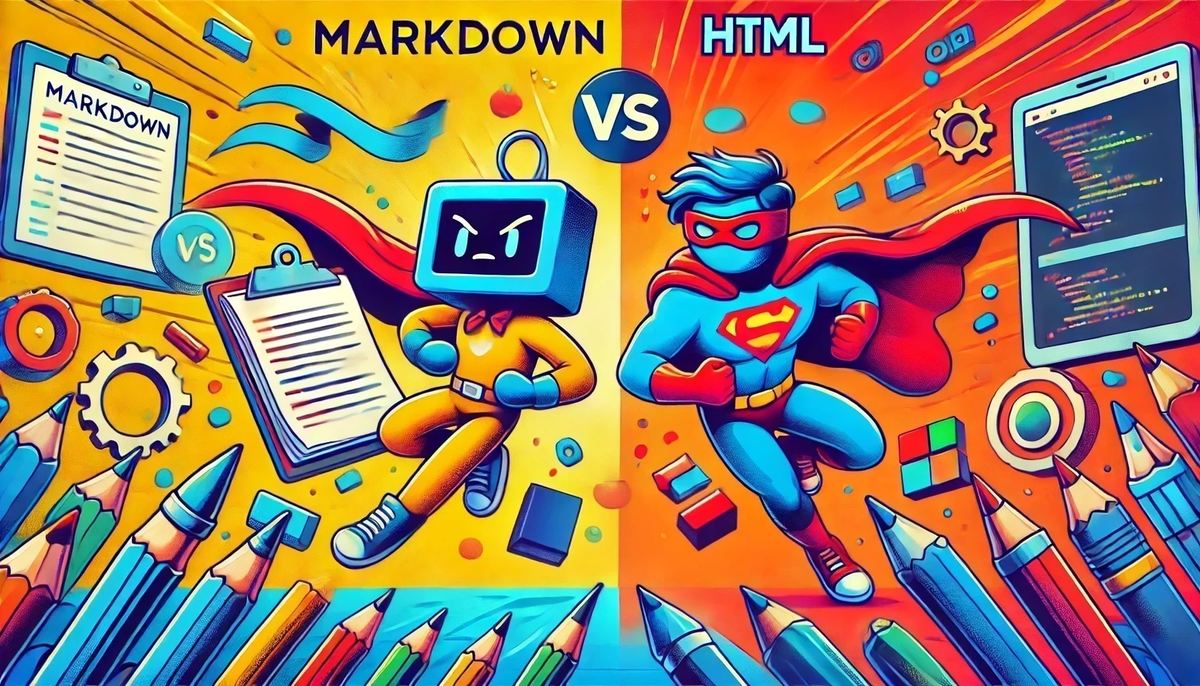So why are we comparing these two? Well, both Markdown and HTML are used to format content for the web, but they serve different purposes and cater to different needs.
In this article, we’ll dive into a straightforward comparison of Markdown and HTML. We’ll explore how they stack up in terms of ease of use, flexibility, speed, and more. By the end, you’ll have a clear picture of which one is right for you, whether you’re writing a blog post, crafting documentation, or building a full-fledged website.
Let’s get started!
1. Ease of Learning and Use
Markdown:
- Ease of Learning: Markdown is incredibly easy to learn. Its syntax is intuitive, with a few simple characters representing various formatting options. Even those with no prior experience in coding can pick it up quickly.
- Ease of Use: Writing in Markdown feels natural and distraction-free. You focus on your content, adding formatting on the go without getting bogged down by complex tags.
HTML:
- Ease of Learning: HTML requires more effort to learn due to its more complex syntax. Understanding tags, attributes, and nesting elements takes time.
- Ease of Use: Using HTML can be cumbersome, especially for those new to it. Each piece of formatting requires specific tags, which can interrupt the writing flow.
2. Readability and Maintainability
Markdown:
- Readability: One of Markdown’s biggest advantages is its readability. Even in its raw form, Markdown is clean and easy to read, resembling the final formatted output.
- Maintainability: Markdown documents are simple and straightforward to maintain. The lack of complex syntax means fewer chances for errors and easier updates. There’s less risk of breaking the document structure compared to HTML.
HTML:
- Readability: HTML can be harder to read, especially for those not familiar with its tags and structure. The raw code can look cluttered and overwhelming.
- Maintainability: Maintaining HTML can be tricky, especially for larger documents. Ensuring that all tags are properly closed and nested requires careful attention.
3. Flexibility and Extensibility
Markdown:
- Flexibility: Markdown is flexible enough for most writing needs, from simple notes to complex documents. However, it has limitations when it comes to creating intricate layouts or interactive elements.
- Extensibility: Markdown can be extended with plugins and tools that add functionality. However, it’s not as inherently flexible as HTML.
HTML:
- Flexibility: HTML is extremely flexible and can be used to create intricate layouts, embed multimedia, and build interactive elements. It’s the go-to for complex web development projects.
- Extensibility: HTML’s extensibility is unmatched. Combined with CSS and JavaScript, it can achieve virtually any design and functionality required for a web project.
4. Compatibility with Different Platforms
Markdown:
- Compatibility: Markdown is highly compatible with various platforms and tools. It’s widely supported by blogging platforms, content management systems (CMS), and version control systems like GitHub.
- Conversion: Markdown can be easily converted to HTML, PDF and other formats, making it versatile for various publishing needs.
HTML:
- Compatibility: HTML is the standard language for web content, so it’s universally supported by all web browsers and platforms. Any content created in HTML will display consistently across different devices and browsers.
5. Speed of Content Creation
Markdown:
- Speed: Markdown allows for fast content creation. Its simple syntax means you spend less time formatting and more time writing.
- Efficiency: The straightforward nature of Markdown means you can produce and format content much faster compared to HTML.
HTML:
- Speed: Creating content in HTML can be time-consuming, especially for those not familiar with its tags and attributes. The need for precise syntax can slow down the content creation process.
- Detail: While it may take longer, HTML allows for more detailed and customized content formatting, which can be worth the extra time for more complex projects.
6. Collaboration and Version Control
Markdown:
- Collaboration: Markdown’s simplicity makes it ideal for collaborative writing. Multiple people can edit a document without worrying about breaking the format.
- Version Control: Markdown works well with version control systems like Git, making it easy to track changes, merge contributions, and manage revisions.
HTML:
- Collaboration: Collaboration on HTML documents can be more challenging due to the complexity of the code. Merging changes from multiple contributors requires careful handling.
- Version Control: While HTML can be used with version control systems, the complexity of the code can make conflict resolution more difficult compared to Markdown.
Understanding these differences can help you choose the right tool for your specific content creation needs.
Markdown and HTML: Main Use Cases
Markdown shines in situations where simplicity and speed are the top priorities. If you’re writing documentation, drafting a blog post, or creating any form of straightforward content, Markdown is your best friend. It’s especially popular among writers and developers who want to focus on their message without getting tangled up in code. For example, if you’re putting together a README file for a GitHub project, or writing a quick blog post, Markdown lets you format text, add links, and create lists with minimal effort. The result is clean, readable content that’s easy to edit and maintain.
Markdown is also great for anyone who needs to create content quickly without needing to worry about detailed formatting. It’s ideal for those who prefer a streamlined workflow and don’t need the extensive customization that HTML offers. If you’re someone who values speed and simplicity over complexity, Markdown is the perfect tool for your needs.
HTML is essential when you need more control and flexibility over your content. It’s the backbone of web development, making it necessary for creating websites, email templates, and any interactive content. If you’re building a custom web page, designing an email campaign, or developing an interactive form, HTML provides the tools you need to do the job right.
HTML is preferred by users who need full control over layout and design. Whether you’re adding multimedia elements like images and videos, styling content with CSS, or incorporating interactive features with JavaScript, HTML allows you to create exactly what you envision. It’s the go-to choice for web developers, designers, and anyone who needs to ensure their content is not only functional but also visually appealing and user-friendly.
Pros and Cons Summary
This pros and cons summary highlights the key strengths and weaknesses of Markdown and HTML, helping you understand which tool is better suited for your needs based on project requirements and skill levels:
Markdown
Pros:
- Simple: Markdown’s greatest strength is its simplicity. You can learn the basics in minutes, and there’s no need to memorize complex syntax. This makes it a great tool for quickly formatting text without much hassle.
- Fast: Because it’s so straightforward, Markdown allows you to write and format content quickly. You can focus on your writing rather than spending time on detailed formatting, which is perfect for tasks like blogging, note-taking, or creating documentation.
- Readable: Even without rendering, Markdown text is clean and easy to read. This makes it easier to manage and edit, especially in collaborative environments where multiple people might be working on the same document.
- Beginner-Friendly: If you’re new to coding or content creation, Markdown is incredibly accessible. Its minimal syntax is easy to pick up, making it an excellent starting point for beginners who want to format content without diving into more complex languages.
Cons:
- Limited Styling Options: While Markdown is great for basic formatting, it doesn’t offer much in the way of customization. You can’t easily change fonts, colors, or layouts, which can be a limitation if you need more sophisticated styling.
- Less Control: With Markdown, what you gain in simplicity, you lose in control. If your project requires detailed customization or advanced features, Markdown’s limitations might become a roadblock.
HTML
Pros:
- Highly Flexible: HTML is incredibly versatile, allowing you to create almost anything you can imagine on the web. Whether you’re building a simple webpage or a complex web application, HTML gives you the flexibility to control every aspect of your content’s presentation.
- Powerful: HTML’s power lies in its ability to integrate with other web technologies like CSS and JavaScript. This combination allows you to create dynamic, interactive, and visually appealing content that can adapt to different devices and screen sizes.
- Universal: HTML is the foundation of the web, making it universally supported across all browsers and platforms. Whether you’re working on a desktop, tablet, or mobile device, HTML ensures your content is accessible to everyone.
Cons:
- Complex: Compared to Markdown, HTML is much more complex. It requires a solid understanding of tags, document structure, and how different elements interact with each other. This complexity can be overwhelming for beginners.
- Time-Consuming: Writing HTML code takes more time than using Markdown, especially for larger projects. The need to manage detailed syntax and structure means you’ll spend more time coding, which can slow down your workflow.
- Steeper Learning Curve: Learning HTML takes more effort and time. While it’s an essential skill for web development, it’s not as easy to pick up as Markdown, which might be a barrier for those looking to quickly format content without diving deep into coding.
Wrapping Up
Ultimately, the choice between Markdown and HTML depends on your specific needs and goals. Consider what you’re trying to achieve and pick the tool that best aligns with your project requirements. Whether you choose Markdown for its simplicity - you can check 2markdown for an easy start - or HTML for its power, you’ll be equipped to create the content you need, in the way that works best for you.
So go ahead, choose the right tool for your next project, and start creating!


